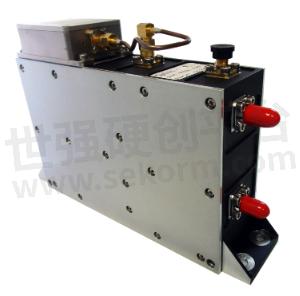Syrlinks Technology Embarks on Board the JUICE Mission

Syrlinks, subsidiary of Safran Electronics & Defense, and leading company in the design of RF Communication systems for Space, is proud to announce its contribution to the ESA JUICE mission (Jupiter Icy Moons Explorer). For this mission, Syrlinks produced a K-band frequency synthesizer integrated in the SWI (Sub-millimeter Wave Instrument) spectrometer, one of the 11 instruments on board the space probe.
The objective of JUICE is to study 3 of Jupiter’s satellites: Callisto, Europa and Ganymede. The central goal of the mission is to determine if conditions to the emergence of life are present in the oceans, as it appears to be on these 3 icy moons. The space probe must also advance scientific knowledge of Jupiter’s atmosphere. The launch is scheduled for April 13, 2023 and the probe will travel during 8 years before reaching the orbit of Jupiter. Then, the duration of the mission will be approximately 4 years. The instruments will be used during these 4 years.
The SWI instrument
The SWI millimeter telescope is an instrument equipped with a 29 cm mirror, it includes two channels, one operating around 600 GHz and the other operating around 1200 GHz. SWI will allow the study of the composition and temperature of the atmospheres of Jupiter and its icy moons. It can detect molecules like water, carbon monoxide, sulfur oxides, hydrogen nitrides and more. The instrument was developed under the responsibility of the MPS* based in Göttingen, Germany. It is the result of a collaboration between different research centers and companies. In this context, Syrlinks was able to collaborate with the Paris Observatory (LERMA**), the MPS, the CNES and the ESA.
*: Max Planck Institute for Solar Systems | **: Laboratory for the Study of Radiation and Matter in Astrophysics and Atmospheres, in France
Syrlinks’ contribution to the SWI instrument is a K-band frequency synthesis device with two independent outputs. These synthesizers are referenced to a high performance Oven Controlled Crystal Oscillator (OCXO). Their output frequency can be programmed in a band ranging from 22.2 to 26.4GHz with a resolution of 150KHz. The technical challenges that have been met to achieve this equipment are as follows: high spectral purity, high output power, low consumption, reduced mass and volume, and a high level of quality and reliability (ESA grade class 1). The project started for Syrlinks in 2012 with a feasibility study, then over the years, Syrlinks delivered demonstrators, carried out an EM (Engineering Model) and finally delivered a flight model (FM) to LERMA in 2021.
“As an R&D engineer, the opportunity to have been able to participate in such an ambitious scientific project as the JUICE mission was a real opportunity. Indeed, most of the projects handled within Syrlinks consist in developing communication equipment for satellites in low orbits. With the realization of the frequency synthesizer for the SWI instrument, we were able to rub shoulders with the universe of astrophysical researchers and work with leading laboratories in their field such as LERMA. As such, this project was really rewarding,” explains Thomas Dehaene, RF and microwave engineer at Syrlinks.
“Participating in these exploration missions is always a great pride for Syrlinks teams. It is the opportunity to use the experience of our experts in the development of complex radio communication functions”, underlines Eric PINSON, Director of the Space activity at Syrlinks. “These advanced technologies will also be integrated on all our products that address space needs beyond exploratory missions. They accentuate our added value and our differentiation,” adds Eric.
“The JUICE project will remain a part of my professional experience because of its scope, its undeniable scientific contribution which inevitably reminds us of the writings of Jules Vernes. This mission allowed us to meet passionate and exciting scientists who gave us the energy to surpass ourselves and to produce the best design for the mission. From a personal point of view, I retain above all very beautiful human exchanges,” completes Fabien SEPOT, former Project Manager for the mission at Syrlinks.

K-band frequency synthesis device, © Syrlinks
- +1 Like
- Add to Favorites
Recommend
- Smiths Interconnect Launches K-band Passive Components for Space Applications
- 17~21.5GHz 16 Channel Dual-Beam RX Beamformer ZRF8366 Designed for Application in K-Band Planar Phased Array Antennas
- Smiths Interconnect New Temperature Variable Attenuator Provides Unparalleled Gain Compensation in K-Band
- RADAR-based Motion Detector Working in the 24GHz-ISM-Band
- Best Practices in Installation and Testing of Board Level Passive Components for Applications at Frequencies of Ka-Band and Above
- Coherent Introduces Wavemaker® and Waveshaper® Optical Solutions For Multi-Wavelength Transmissions
- Renesas Low-Noise Power Supply for Timing and Clock ICs
- Loft Orbital Selects Syrlinks High-Data-Rate X-Band Transmitter for Their “Longbow” Satellites
This document is provided by Sekorm Platform for VIP exclusive service. The copyright is owned by Sekorm. Without authorization, any medias, websites or individual are not allowed to reprint. When authorizing the reprint, the link of www.sekorm.com must be indicated.






























































































































































































































































































































































































































































































































































































































































































































































































































































































